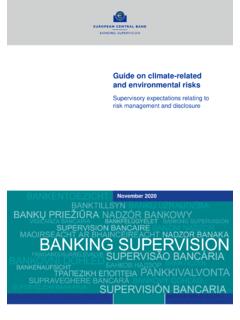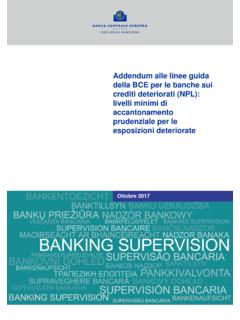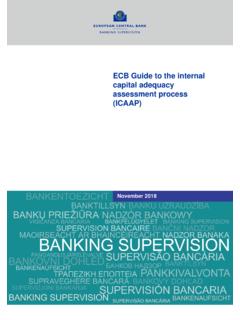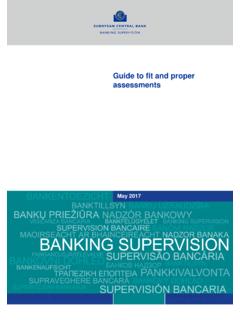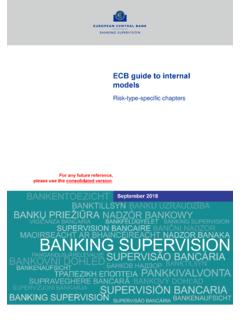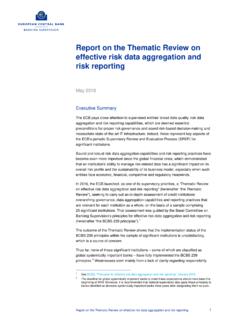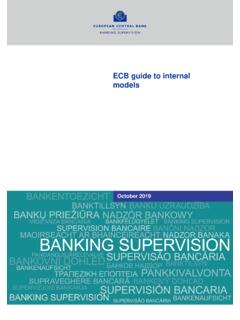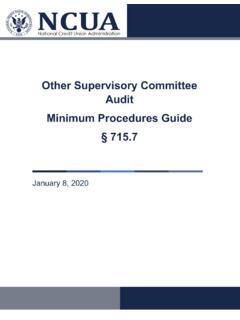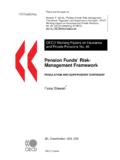Transcription of SSM Supervisory Manual - Europa
1 SSM Supervisory Manual European banking supervision: functioning of the SSM and Supervisory approach March 2018 SSM Supervisory Manual Contents 1 Contents Use of the Supervisory Manual 3 Introduction 3 Mission statement 4 The strategic intents of the Eurosystem and the Single Supervisory Mechanism 4 Organisational principles for the Eurosystem and the Single Supervisory Mechanism 6 1 Functioning of the Single Supervisory Mechanism 8 The organisation of the SSM 8 Operating structure of the SSM 10 Decision-making within the SSM 16 Cooperation with other institutions and
2 Authorities 30 2 Supervisory cycle 41 Contributing to regulations and Supervisory policies 42 Defining and developing methodologies and standards 43 Carrying out day-to-day supervision 45 Enhancing banking supervision 45 3 Conduct of SSM supervision exercised over all supervised institutions 49 Assessing requests for authorisations for proposed acquisitions of qualifying holdings in a credit institution and passporting 50 Assessing the significance of institutions 57 4 Supervision of significant institutions 61 Strategic and operational planning 61 Risk analyses to identify and assess key risks and vulnerabilities 65 Collecting Supervisory data 68 Assessing the suitability of members of management bodies (fit and proper assessment)
3 72 SSM Supervisory Manual Contents 2 Conducting ongoing supervision 77 Carrying out the SREP 80 Ongoing monitoring of internal models 88 Conducting on-site inspections 89 Assessing ad hoc requests, notifications and applications 89 Preventing and managing crisis situations 95 Supervisory powers, enforcement measures and sanctions 98 Assessing the eligibility of and monitoring institutional protection schemes 105 5 Supervision of less significant institutions 106 Oversight of NCA Supervisory practices 107 Development of standards for LSI supervision 107 Providing analytical and methodological support 109 Oversight of LSIs and LSI sectors 110 Glossary 117 Abbreviations 120 SSM Supervisory Manual Use of the Supervisory Manual 3 Use of the Supervisory Manual The Supervisory Manual describes the organisational
4 Set-up of the Single Supervisory Mechanism (SSM) and defines the methodologies, processes and procedures for banking supervision in the euro area. It also explains how the SSM cooperates with other authorities in the wider institutional framework. The Manual first describes how the SSM is organised and how it discharges its Supervisory tasks and then details how supervision is conducted in practice. It is not a legally binding document, does not establish new regulatory requirements and cannot, in any way, replace the legal requirements laid down in the relevant applicable EU law.
5 It sets out the approach to be followed by the SSM in carrying out its Supervisory tasks. T he SSM is empowered to depart from the general policy established in this Manual if there are factors in specific cases that justify doing so and if sufficient rationale is provided. The divergent policy choice must also be compatible with the general principles of EU law, in particular equal treatment, proportionality and the legitimate expectations of supervised entities. This is consistent with established case-law of the Court of Justice of the European Union where internal guidance, such as this Manual , is defined as rules of practice from which EU institutions may depart in justified cases.
6 For example, paragraph 209 of the judgement of the Court of Justice of the European Union of 28 June 2005 in Joined Cases C-189/02, C-202/02, C-205/02 to C-208/02 and C-213/02 stipulates: The Court has already held, in a judgment concerning internal measures adopted by the administration, that although those measures may not be regarded as rules of law which the administration is always bound to observe, they nevertheless form rules of practice from which the administration may not depart in an individual case without giving reasons that are compatible with the principle of equal treatment.
7 Such measures therefore constitute a general act and the officials and other staff concerned may invoke their illegality in support of an action against the individual measures taken on the basis of the measures. The ECB is publishing this Manual , drafted with the assistance of the national competent authorities (NCAs), as part of its transparency policy. Introduction The Single Supervisory Mechanism (SSM) was set up as the first pillar of the European banking union, alongside the Single Resolution Mechanism (SRM) and the European Deposit Insurance Scheme (EDIS) now being discussed.
8 The three pillars rest on the foundation of the single rulebook, which applies to all EU countries. European banking supervision aims to contribute to the safety and soundness of credit institutions and the stability of the financial system by ensuring that banking supervision across the euro area is of a high standard and is consistently applied to all banks. SSM Supervisory Manual Use of the Supervisory Manual 4 While retaining ultimate responsibility, the European Central Bank (ECB) carries out its Supervisory tasks within the SSM, comprising the ECB and national competent authorities (NCAs).
9 This structure provides for strong and consistent supervision of all supervised entities across the euro area, while making the best use of the local and specific know-how of national supervisors. On the basis of the tasks entrusted to the ECB by the European legislator, the SSM authorities have defined a mission statement for the SSM and determined its Supervisory principles. Mission statement Within the SSM, composed of the ECB and NCAs, the ECB carries out its Supervisory tasks. The ECB is responsible for the effective and consistent functioning of the SSM, with a view to carrying out intrusive and effective banking supervision, contributing to the safety and soundness of the banking system and the stability of the financial system.
10 In pursuing our objectives, we in the SSM attach utmost importance to credibility and accountability. In performing our tasks we are transparent while fully observing the applicable confidentiality requirements. We aim for effective communication with the citizens of Europe. We are committed to conducting our relations with European and national authorities in full accordance with the relevant law and with due regard to the principle of independence. We develop a Supervisory approach that meets the highest international standards. We will implement the EU policies on the prudential supervision of banks in a coherent and effective manner, based on a best practice framework for independent, forward-looking and risk-based supervision.

